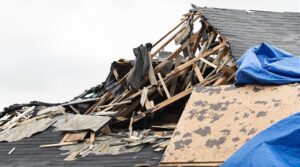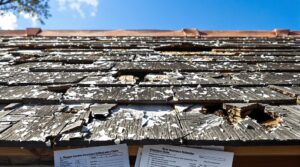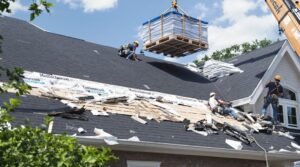HOA coverage for roof repairs and replacements varies based on the property type and governing documents. In townhouse and condominium communities, HOAs typically manage exterior maintenance, including roofs. Single-family home communities usually require individual owners to handle their own repairs. All roof work must meet HOA standards and undergo proper approval processes. Master insurance policies may provide additional coverage for specific types of damage. Understanding the specific terms within community documents determines exact coverage obligations.
Key Takeaways
- Coverage depends on your HOA's governing documents, with townhouse and condo communities typically including roof maintenance responsibilities.
- Single-family home HOAs usually require owners to handle their own roof repairs, while following HOA standards.
- HOA master insurance policies generally cover shared structures and roofs for condos and townhouses.
- Regular roof inspections are required in spring/fall and after severe weather to maintain HOA coverage eligibility.
- State regulations and HOA bylaws ultimately determine the specific scope of roof repair responsibilities and coverage.
Understanding HOA Roof Coverage Basics
The coverage of roof repairs by Homeowners Associations (HOAs) involves a complex interplay of governing documents, insurance policies, and property type considerations. Multiple factors influence the extent of coverage basics, including the age of the roof, type of damage sustained, and specific terms outlined in the HOA's governing documents.
Financial responsibilities for roof repairs and replacements typically depend on whether the property consists of shared structures or individual units. In townhouse and condominium communities, HOAs generally maintain responsibility for structural elements, including roofs in common areas.
However, the scope of coverage can vary substantially based on the HOA's insurance policy and state regulations. Individual homeowners may bear partial or full responsibility for roof maintenance in single-family homes, while shared structures often fall under collective HOA coverage. Understanding these distinctions requires careful review of HOA agreements and applicable state laws governing property maintenance obligations. Condo owners should verify their loss assessment coverage to protect against shared repair expenses that exceed the HOA master policy limits.
Types of Roof Damage Covered by HOAs

When examining roof damage coverage by HOAs, it becomes necessary to distinguish between different types of incidents and their respective coverage parameters.
HOAs typically provide extensive coverage for damage resulting from severe weather events across various storm categories, including hurricanes and significant weather systems that affect shared structural elements.
Coverage generally extends to age-related deterioration of roofing systems, particularly in shared structures like condominiums and townhouse communities.
The HOA's master insurance policy usually addresses structural damage to common elements, ensuring the integrity of shared roofing components. This coverage framework reflects the collective responsibility for maintaining vital building elements that affect multiple units.
HOAs implement preventive measures through regular inspections and maintenance schedules to protect these shared assets. The extent of coverage often depends on whether the damaged components are classified as common elements, with repairs and replacements managed through the association's reserve funds and insurance policies.
Claims for HOA roof repairs can take anywhere from a few days to several months depending on the complexity of the damage and assessment process.
Distinguishing Between HOA and Homeowner Responsibilities
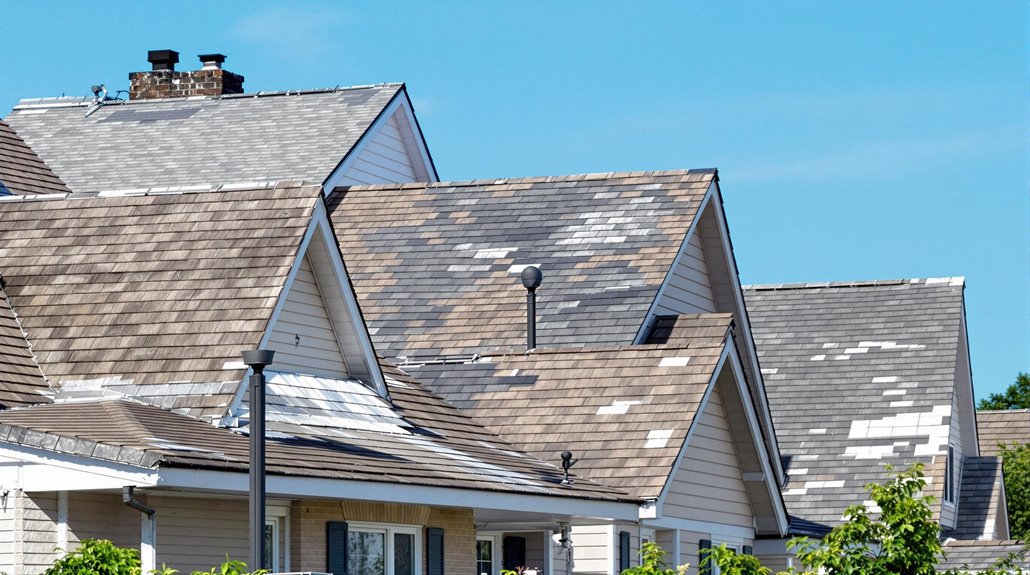
Understanding the boundaries between HOA and homeowner responsibilities requires careful examination of the association's governing documents and specific property type.
For condominium and townhouse communities, HOAs typically manage exterior maintenance including roof repairs as part of shared expenses, while single-family homeowners generally bear responsibility for their own roof maintenance and replacement costs.
Clear differentiation of these maintenance obligations helps prevent disputes and guarantees proper care of roofing systems, though all repairs must comply with HOA-established standards regardless of responsibility assignment.
In cases of storm damage, homeowners should promptly file insurance claims and document all damage with photographs while following HOA repair guidelines.
Defining Coverage Boundaries Clear
Determining clear boundaries between HOA and homeowner responsibilities stands as a critical first step in roof maintenance and repair scenarios. Coverage limits and boundary distinctions are typically outlined in governing documents, particularly the CC&Rs, which specify maintenance obligations for both parties.
| Responsibility Area | HOA Coverage | Homeowner Coverage |
|---|---|---|
| Common Areas | Structural repairs | Interior damage |
| Individual Units | External surfaces | Personal modifications |
| Weather Damage | Insurance claims | Negligence-related issues |
State laws, property type, and the nature of damage influence these boundaries. For example, California’s Civil Code Section 4775 requires HOAs to maintain common areas unless specifically stated otherwise. Understanding these distinctions helps prevent disputes and guarantees proper maintenance protocols are followed, ultimately protecting both the community’s interest and individual property values. Many HOA insurance policies include loss assessment coverage to help fund repairs when damages exceed the association’s primary coverage limits. Additionally, it is crucial for homeowners to familiarize themselves with their HOA’s specific policies regarding water damage, as these can vary significantly between associations. Many find that understanding HOA responsibilities for water damage can provide clarity on what repairs are covered and what individuals may need to address themselves. Effective communication between homeowners and HOA boards also plays a vital role in ensuring that all parties are aware of their obligations and that preventive measures are implemented to mitigate potential damages.
Shared Vs Individual Maintenance
The distinction between shared and individual maintenance responsibilities forms the cornerstone of effective HOA property management. HOAs typically handle maintenance of common elements, including structural components like roofs, exterior walls, and shared utilities, with costs distributed among all members through regular dues.
Individual homeowners bear responsibility for maintaining elements within their units, such as interior walls, fixtures, and personal appliances.
In cases involving limited common areas, such as shared balconies, mutual responsibilities are often established between the HOA and specific unit owners who benefit from these spaces. This arrangement creates a balanced framework of shared costs and obligations, guided by the association's governing documents and state regulations, ensuring proper maintenance of both communal and private property elements.
Insurance Policies and Roof Coverage in HOA Communities
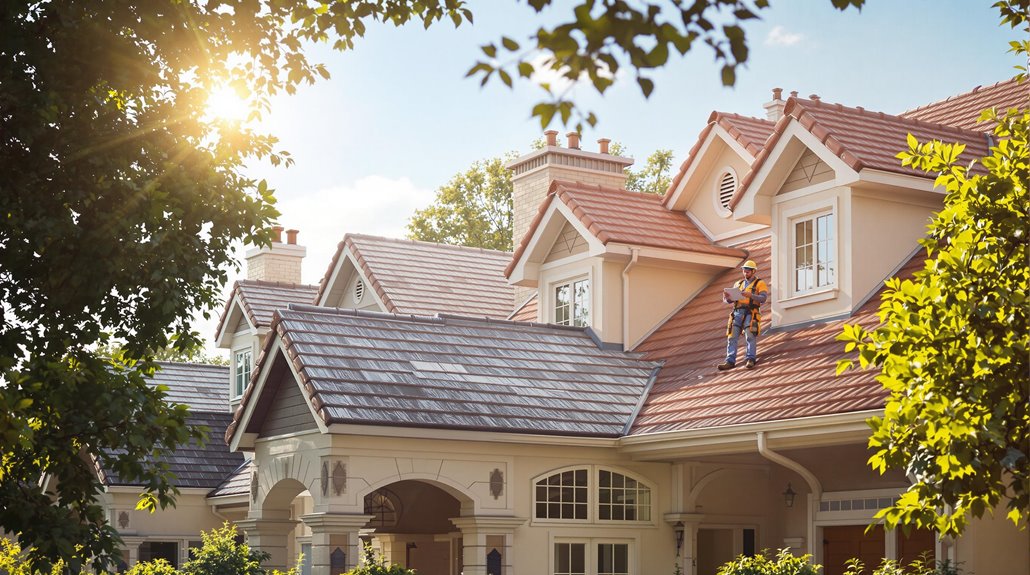
Insurance policies governing roof coverage in HOA communities represent a complex interplay between homeowners association master policies and individual insurance requirements. Coverage limitations and deductible requirements vary substantially based on factors such as property type, age of the roof, and specific terms outlined in governing documents.
Standard homeowners insurance policies typically address damage from sudden events, while HOA master policies focus on shared structures.
Key considerations for understanding roof coverage include:
- Age-based restrictions may limit coverage for roofs over 20 years old to actual cash value rather than replacement cost
- Gradual deterioration and cosmetic damage often fall outside standard coverage parameters
- Natural disasters and sudden accidents generally qualify for coverage under both individual and master policies
- Shared responsibility arrangements between HOAs and homeowners may require specific documentation and claim procedures
Property owners must carefully review both their individual policies and HOA documents to fully understand their coverage obligations and entitlements.
Extended replacement cost coverage can provide 10-50% additional protection beyond standard dwelling coverage limits for unexpected roof repair costs.
Maintenance Requirements and Prevention Guidelines

Effective maintenance protocols and preventive guidelines form the cornerstone of HOA roof management strategies. A complete maintenance schedule typically includes biannual inspections conducted in spring and fall, with additional assessments following severe weather events. HOAs must establish detailed prevention guidelines that outline specific tasks, including gutter cleaning, debris removal, and thorough examination of shingles and flashing.
Documentation plays a crucial role in the maintenance process, requiring detailed records of all inspections, repairs, and identified issues, supported by photographic evidence.
HOAs should implement a customized maintenance plan that addresses both individual units and shared structures, allocating adequate funds in the annual budget for routine upkeep. Working with trusted roofing contractors guarantees professional oversight and early detection of potential problems. Regular review and updates to these maintenance protocols help associations maintain property values while preventing costly emergency repairs through systematic preventive care.
Legal Framework for HOA Roof Repairs
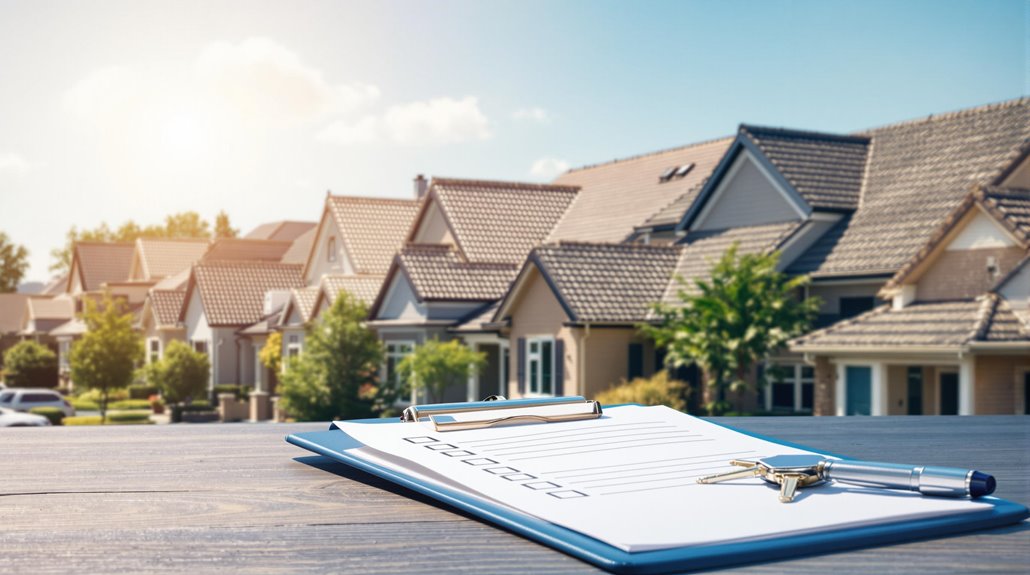
Legal clarity regarding roof repair responsibilities forms the foundation of HOA governance structures.
The statutory authority of homeowners associations varies by state, with specific jurisdictional limitations determining the scope of their maintenance obligations.
State regulations and consumer protection laws establish the fundamental framework within which HOAs must operate, particularly concerning structural elements like roofs.
- HOA governing documents, including CC&Rs and bylaws, must align with state laws while defining specific responsibilities for roof maintenance and repairs
- Local building codes and regulations create additional compliance requirements that HOAs must incorporate into their maintenance protocols
Navigating the Roof Repair Approval Process

The HOA roof repair approval process begins with a formal review request to the board, accompanied by complete documentation detailing the scope of repairs and contractor qualifications.
Property owners must submit required permits, material specifications, and proof of contractor insurance as part of the standard documentation package.
Emergency roof repairs may follow an expedited protocol, though homeowners should still notify the HOA immediately and provide post-repair documentation to maintain compliance.
Requesting Board Review First
Before initiating any roof repairs, homeowners must navigate a structured approval process through their HOA board review system.
Proper board etiquette requires submitting a detailed application form and following established protocols to guarantee compliance with community standards.
- Submit a thorough application that includes project specifications, material choices, contractor information, and proposed timeline
- Allow sufficient time for the review process, which typically spans between two to eight weeks
- Provide samples of roofing materials and color selections that align with architectural guidelines
- Wait for official board approval before purchasing materials or scheduling contractors
The request timeline may vary depending on the complexity of the project and the HOA's meeting schedule.
Failure to obtain prior approval can result in fines, legal action, or mandatory project modifications to meet community standards.
Documentation and Permit Requirements
When undertaking roof repairs in HOA communities, homeowners must compile exhaustive documentation packages that satisfy both association requirements and local building codes. Essential documents include building permit applications, detailed project plans, and HOA approval forms. The permit timing typically involves sequential steps, starting with HOA authorization before proceeding to municipal permits.
Document submission requirements vary by jurisdiction but generally include proof of contractor licensing and insurance, architectural drawings, and material specifications.
Many HOAs require documentation showing compliance with their established roofing guidelines, particularly regarding material selection and design standards. The master insurance policy and individual HO-6 coverage documentation may also be necessary when repairs result from damage claims. Proper documentation guarantees smooth project progression and helps prevent delays or complications during inspections. Working with independent insurance agents can streamline the documentation process by providing efficient claims management systems and expertise in navigating coverage requirements.
Emergency Repairs Protocol
Understanding emergency roof repair protocols remains essential for both HOA management and homeowners to effectively address urgent situations while maintaining compliance with association guidelines.
When faced with emergency roof issues, following established damage control procedures helps minimize property damage and guarantees proper resolution.
Key steps in emergency protocols include:
- Immediate assessment of the situation to determine urgency and responsibility for repairs
- Implementation of temporary measures, such as tarps or water shut-offs, to prevent further damage
- Clear communication between homeowners and HOA regarding the damage and required actions
- Execution of necessary repairs following documented emergency procedures while maintaining compliance
HOAs should maintain an emergency response plan with pre-approved vendors and clear guidelines for urgent situations, safeguarding swift action while protecting both property and homeowner interests.
Working with public adjusters can increase roof damage claim settlements by 30-50% when navigating complex repairs through insurance.
Common Disputes and Resolution Strategies

Homeowners and HOA boards frequently encounter disputes regarding roof repair responsibilities, particularly when damage occurs in shared or adjacent structures.
Common points of contention include determining whether damage resulted from normal wear versus neglect, and establishing coverage boundaries in townhouse communities where roofing systems are interconnected.
Resolution options typically begin with reviewing governing documents and insurance policies to clarify responsibilities.
When disagreements persist, mediation strategies often involve obtaining professional assessments from licensed contractors to provide unbiased evaluations. Open communication channels between homeowners and HOA boards remain essential for addressing concerns promptly and effectively.
State regulations and contractual obligations outlined in HOA agreements serve as fundamental guidelines for resolving disputes.
When informal resolution attempts prove unsuccessful, legal assistance may become necessary to interpret complex coverage issues and enforce compliance with established community standards and maintenance requirements.
In particularly challenging cases, engaging a public adjuster can help expedite claim negotiations and ensure fair property damage assessments before pursuing legal action.
The Benefits Of Consulting A Public Adjuster
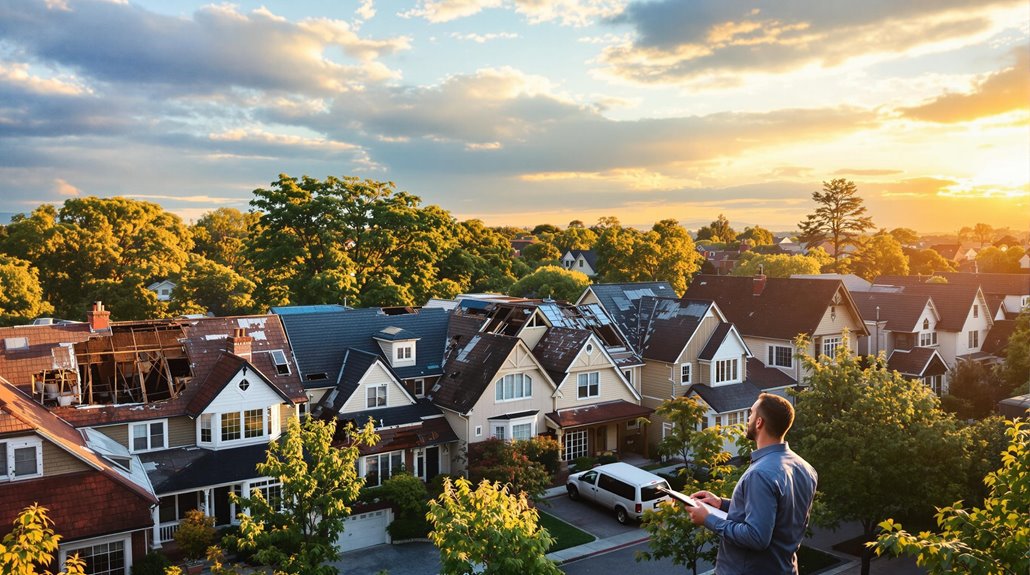
Public adjusters offer essential expertise in managing complex insurance claims for HOA roof repairs through their thorough understanding of policy terms and coverage requirements.
Their objective damage assessments and professional representation help streamline the claims process while ensuring all damages are properly documented and evaluated.
Professional public adjusters frequently secure higher claim settlements through skilled negotiations with insurance companies, maximizing the financial recovery for HOA roof repairs.
Studies show that engaging a public insurance adjuster results in settlements that are up to 800% higher compared to claims filed without professional representation.
Expertise In Insurance Claims
When facing complex insurance claims for HOA roof repairs, consulting a public adjuster can provide significant advantages in maneuvering. With access to pre-vetted expert adjusters through networks like PCAN, property owners can ensure professional handling of their claims.
Objective Damage Assessment
A thorough objective damage assessment conducted by a public adjuster serves as a critical foundation for resolving roof-related insurance claims within HOA communities. Through complete damage verification protocols, public adjusters employ specialized equipment to detect both visible and concealed roof damage, guaranteeing no issues go undocumented.
The impartial nature of these assessments proves invaluable when handling complex relationships between homeowners, HOAs, and insurance providers.
Professional assessors follow strict assessment protocols to create detailed reports that substantiate insurance claims and clarify financial responsibilities. These unbiased evaluations help homeowners understand their coverage obligations while providing essential documentation for negotiating with HOAs and insurance companies. By maintaining objectivity throughout the process, public adjusters help protect homeowners from unexpected costs and guarantee fair compensation for legitimate roof damage claims. Their expertise typically results in 20-50% higher settlements when compared to claims filed without professional assistance.
Streamlined Claim Process
Three key advantages emerge when consulting a public adjuster for HOA roof claims: simplified documentation, efficient communication, and expedited processing times.
Their professional expertise guarantees accurate claim submission while maintaining regulatory compliance throughout the process.
A public adjuster streamlines the claim process through:
- Complete documentation management, reducing the risk of claim denials through efficient documentation practices
- Direct communication channels between HOA representatives and insurance providers
- Accelerated outcomes through focused claim lifecycle management
- Professional assessment of damage and fair compensation determination
Their industry knowledge and established relationships with insurance companies help navigate complex procedures while maintaining organized records.
This systematic approach minimizes delays, guarantees thorough documentation, and facilitates smoother processing of HOA roof repair claims through the insurance system.
Public adjusters typically secure higher settlement amounts compared to initial insurance company offers, making their expertise particularly valuable for substantial HOA claims.
Higher Claim Payouts & Settlements
Public adjusters consistently deliver higher claim payouts for HOA roof repairs, with studies indicating an average settlement increase of 19% compared to self-managed claims. This settlement maximization stems from their expertise in policy interpretation and exhaustive damage assessment protocols.
Through effective adjuster advocacy, these professionals identify often-overlooked damage components and guarantee proper documentation of all legitimate claims.
Their contingency-based fee structure, typically ranging from 5% to 20% of the final settlement, aligns their interests with the HOA's goals. This motivation, combined with their specialized knowledge of insurance policies and negotiation experience, enables public adjusters to secure more favorable outcomes. Their thorough understanding of coverage details and ability to prevent claim undervaluation makes them valuable assets in maximizing insurance settlements for HOA roof repairs.
Unlike insurance company adjusters who must follow company guidelines, public adjusters work solely to protect the policyholder's interests during the claims process.
About The Public Claims Adjusters Network (PCAN)

While property owners navigate complex insurance claims, the Public Claims Adjusters Network (PCAN) serves as a professional organization connecting licensed public adjusters across the United States.
This network plays a vital role in supporting HOA-related roof claims by facilitating adjuster networking and providing claims education to its members.
PCAN's involvement in HOA roof claims includes:
- Maintaining a database of licensed adjusters specializing in HOA and condominium association claims
- Providing ongoing education about complex coverage scenarios involving master policies and individual unit policies
- Facilitating collaboration between adjusters handling similar HOA roof damage claims across different regions
- Establishing best practices for documenting and processing claims involving common elements versus individual units
Through its professional network, PCAN helps guarantee that HOA roof claims are handled efficiently, with proper attention to governing documents, insurance policies, and state regulations.
This systematic approach helps streamline the claims process while maintaining compliance with HOA guidelines and insurance requirements.
Members must provide client status updates at minimum every 10 days to ensure transparent communication throughout the claims process.
Frequently Asked Questions
How Long Does a Typical HOA Roof Replacement Approval Process Take?
In Oakwood Hills HOA, approval timeline typically ranges from 2-8 weeks, depending on committee schedules and documentation completeness. Processing delays can occur due to incomplete submissions or seasonal review backlogs.
Can Homeowners Upgrade to Premium Roofing Materials if They Pay the Difference?
Homeowners can typically select material upgrades and premium options if they comply with HOA regulations and cover additional costs beyond standard specifications. Written board approval remains mandatory for all roofing modifications.
Are Solar Panel Installations Affected by HOA Roof Repair Policies?
Sunlight dances across rooftops as panel placement must align with HOA guidelines. Installation timing should coordinate with scheduled roof repairs to guarantee structural integrity and compliance with association policies.
Do HOAS Typically Offer Payment Plans for Special Assessments on Roof Projects?
HOAs commonly provide payment plans for special assessments, allowing homeowners to manage costs through monthly installments rather than lump sums. Payment schedules can be customized based on financial circumstances.
What Happens if an HOA Lacks Sufficient Reserves for Emergency Roof Repairs?
Like a house of cards, insufficient HOA reserves can trigger financial planning crises, leading to special assessments, potential insurance disputes, and emergency borrowing to fund critical roof repairs.
References
- https://onenationexteriors.com/blog/do-townhouse-hoa-include-roof/
- https://www.summitroofingandrestoration.com/atoka/blog/roof-replacement-and-your-hoa-whos-responsible-for-which/
- https://hoamemberservices.com/resources/does-hoa-cover-roof-replacement/
- https://kickapooroofing.com/blogs/does-hoa-cover-roof-replacement/
- https://www.gorillaroofing.com/resources/hoa-obligation-after-leaking-roof/
- https://blog.vendorsmart.com/roofing-maintenance-and-post-replacement-care/
- https://www.hoatalk.com/Forum/tabid/55/forumid/1/postid/372337/view/topic/Default.aspx
- https://www.johnstonroofing.com/roofing/roof-replacement-and-your-hoa-whos-responsible-for-what/
- https://onenationexteriors.com/blog/roof-maintenance/
- https://www.condocontrol.com/blog/hoa-vs-homeowner-repairs/
